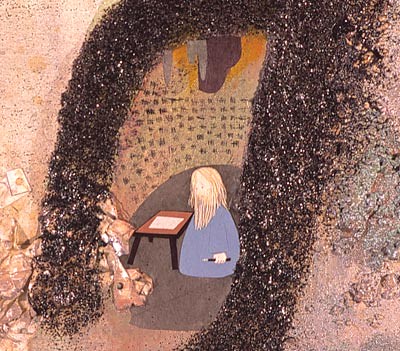.The
Katharina Grosse lecture yesterday was inspiring - if you didn't go you missed out. She shared so much yet I think we only got a glimpse. Here are my notes - feel free to add subtract negate extol decry in the comments:
Katharina Grosse studied in Dusseldorf, a Richmond-sized city, under
Gerhard Richter and
Jorg Immendorf (and the shadow of
Beuys) and along with
Thomas Struth,
Andreas Gursky, and
Katharina Fritsch. That might not be
exactly right but the first artists were the big local influences at her school and the younger three were peers she had frequent contact with.
Photography was THE THING and she had to deal with the ongoing problem of being confronted with "painting is over" and having to defend the medium. She talked about going out for beers with artist friends who would ask "what did you do today?" to which she would answer "paint" and they would respond with "why?". Very frustrating.
Nam Jun Paik also taught while she was studying there and so she tried to get into video and photography and other things but after two or three years she didn't know what to do anymore and realized that the only thing all her experiments in different media had in common was the use of color. She decided to go back to painting.
The first question she asked herself after accepting herself as a painter was "should paint be thick or thin"? She thought "it should be very present" and so chose
thick. She made some works with really thick blobs of paint but after they dried some of them would slide off the canvas so she thought "maybe that's the wrong way to go, maybe I should go thin".
Her first thin paintings were very simple strokes of overlapping color left to right and top to bottom. Painting a second color over the first had the effect of taking a quantity away. It was a way of mixing colors and making the colors ambiguous. What looks "blue" can't so easily be called "blue".
An opportunity came up to paint directly on the wall for a company cafeteria/break-room and she was happy with the results, thinking the workers would like it because it was "very colorful, very beautiful" - unfortunately the work was not popular with the staff, who said it was "not a painting". Another opportunity to paint directly on a wall arose and she was especially interested in that piece's relationship with a nearby door.
Then in 1998 she was invited to participate in a museum show in Switzerland in which they said she could do whatever she wanted. She visited the space and decided she should have a painting in the corner, not centered on any of the walls.
This dark green rectangle was her first spray piece and one of the exciting things she learned making it was that the corner would disappear - "I was creating an illusionistic space within the built space".
As an artist-in-residence at Marfa she was able to make a work that related to the whole building. The exciting discovery here
was in painting over the door in the middle of the wall and making a painting you could "walk through" (I'm starting to think of
James Hyde and his
handles - another painter whose work seems to want to take us somewhere
). The door in the Marfa building is a very specific door - not your generic door - which lent the piece added narrative. Sort of ominous.
The other big thing learned painting over this door in Marfa was in painting over the door's handle - spraying over the handle left an after-image behind it. This was her first time to notice this time element adding effect
.
Part 2




